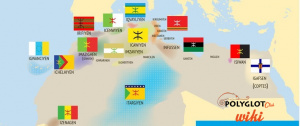Language/Kabyle/Grammar/Adjectives
| ◀️ Relationships — Previous Lesson | Next Lesson — Adverbs ▶️ |
Hi Kabyle learners! 😊
In this lesson, we will learn about adjectives in Kabyle. We will explain what adjectives are, how they work in Kabyle grammar, and provide some examples. By the end of this lesson, you should have a good understanding of how to use adjectives in Kabyle.
Take some time to dive into these other pages after completing this lesson: Kabyle verb, Plural, Give your Opinion & How to Use Be.
What are adjectives?
Adjectives are words that describe nouns (people, places, things, or ideas) by giving us more information about them. In Kabyle, adjectives usually come after the noun they modify, unlike in English where they often come before the noun.
Here are some example sentences:
- [noun] [adjective] (meaning: [translation])
- ⵣⴰⵖⴻⵔ ⴰⵙⴳⵔⴰⵙ (meaning: green grass)
- ⵉⴷⵉ ⴳⵉⴷ (meaning: big house)
- ⴰⵔⴰⵔ ⴰⵣⴰⵍ (meaning: red shirt)
Adjective agreement
In Kabyle, adjectives have to agree with the noun they modify in terms of gender and number. This means that the adjective has to change its form based on whether the noun is masculine or feminine, and whether it is singular or plural.
Here is an example table that shows the different forms of the adjective "idurar" (small) depending on the gender and number of the noun it modifies:
| Masculine Singular | Feminine Singular | Masculine Plural | Feminine Plural | |
|---|---|---|---|---|
| Small | ⵉⴷⵉⵔⵜ | ⵉⴷⵉⵔⵜⴰ | ⵉⴷⵉⵔⵜⴻⵎ | ⵉⴷⵉⵔⵜⴰⵎ |
Here are some example sentences:
- ⵜⴰⵜⴰ ⵉⴷⵉⵔⵏ (meaning: a small cat)
- ⵜⴰⵜⴰ ⵉⴷⵉⵔⵜⴰ (meaning: a small house)
- ⵜⴰⵜⴰ ⵉⴷⵉⵔⵜⴻⵎ (meaning: small cats)
- ⵜⴰⵜⴰ ⵉⴷⵉⵔⵜⴰⵎ (meaning: small houses)
Comparative and superlative adjectives
In Kabyle, we use "d-yesseqdac" as a comparative adjective to make comparisons between two things. For example:
- ⵜⴰⵜⴰⵎⴰⵙⵏⵜ ⵣⴰ ⵜⴰⵜⴰ ⵜⵉⵏⵉⵙ ⴷⵉⵔ ⴷⵢⴰⵏ ⴰⵣⴻⵎ. (meaning: This cat is smaller than that dog.)
To form the superlative, we use "tt-yesseqdac" followed by the noun. For example:
- ⵜⴰⵜⴰⵎⴰⵙⵏⵜ ⵜⵉⵣⴰⵍⵜ ⵜⵜⵉⵏ ⵜⴰⵜⴰ ⵜⴻⵔⴰⵢⴻⵏⵜ. (meaning: This cat is the smallest of all.)
Practice dialogue
- Person 1: ⴰⵔⴰⵔ ⴰⵥⴰⵔ (meaning: Blue sky)
- Person 2: ⴰⵔⴰⵔ ⴰⵥⴰⵔ ⴰⵢⵜⵔⵉ (meaning: The sky is blue)
- Person 1: ⵜⴰⵜⴰ ⵉⴷⵉⵔⵜⴻⵎ ⵣⴰⵡⴰⵍ (meaning: Small cats are cute)
- Person 2: ⵜⴰⵜⴰ ⵉⴷⵉⵔⵜⴻⵎ ⵣⴰⵡⴰⵍ. (meaning: Small cats are cute.)
Conclusion
In this lesson, we learned about adjectives in Kabyle. We explained what adjectives are, how they work in Kabyle grammar, and provided some examples. We also looked at adjective agreement and discussed comparative and superlative adjectives.
It is important to practice using adjectives in context to fully understand and master their usage. To improve your Kabyle Grammar, you can also use the Polyglot Club website. Find native speakers and ask them any questions!
Don't forget to go to the Kabyle [Language/Kabyle/Grammar|Grammar] section of Polyglot Club for more lessons. Happy learning! 😊
➡ If you have any questions, please ask them in the comments section below.
➡ Feel free to edit this wiki page if you think it can be improved. 😎
Now that you've completed this lesson, don't stop learning! Check out these related topics: Types of nouns, Future Tense, Nouns and gender & Exam 2 Kabyle Noun Correction.
Other Lessons
- How to Use Be
- Types of nouns
- Kabyle verb
- Exam 2 Kabyle Noun Correction
- Future Tense
- Pronouns
- Give your Opinion
- Plurals
- Plural
Sources
| ◀️ Relationships — Previous Lesson | Next Lesson — Adverbs ▶️ |

